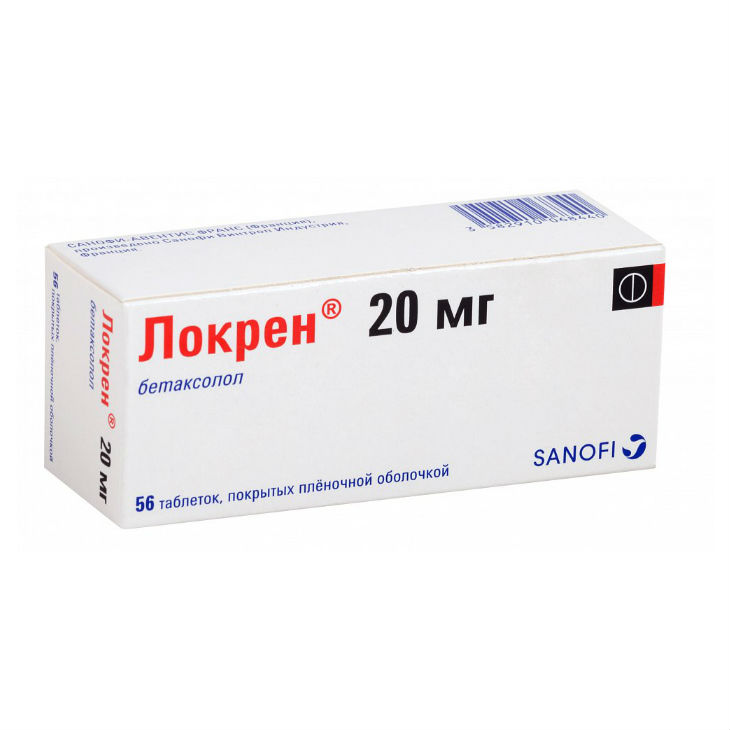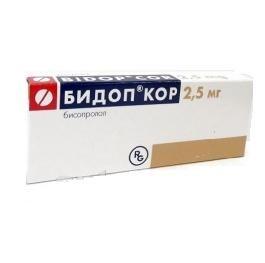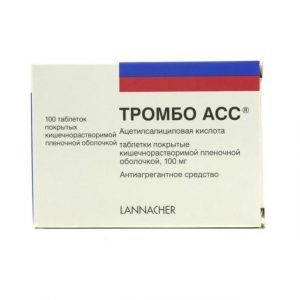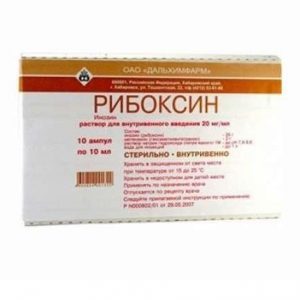Description
Release form
coated tablets.
Packing
In a blister pack of 14 tablets. There are 4 blisters in the package.
Pharmacological action
Selective beta1-blocker. Betaxolol is characterized by three pharmacological properties: a cardioselective beta1-adrenergic blocking effect, the absence of partial agonistic activity (lack of internal sympathomimetic activity), weak membrane-stabilizing effect (similar to the action of quinidine or local anesthetics) at concentrations exceeding therapeutic.
It should be noted that the selective effect of betaxolol on 1-adrenergic receptors is not absolute, so when used in high doses, it may affect betaxolol on 2-adrenergic receptors, located mainly in the smooth muscles of the bronchi and blood vessels (however, the effect of betaxolol on 2-adrenergic receptors are significantly weaker than that of non-selective beta-blockers).
When betaxolol is used, its blocking 1-adrenergic receptor activity is manifested by the following pharmacodynamic effects:
decreased heart rate at rest and during physical activity (due to blockade of -adrenoreceptors in the sinus node, which, combined with the absence of internal sympathomimetic activity of betaxolol, slows down automatism sinus node)
reduction in cardiac output at rest and during exercise due to competitive antagonism with catecholamines in peripheral (especially cardiac) addresses ergic nerve endings
reduction in systolic and diastolic blood pressure at rest and during physical activity (antihypertensive action mechanism is described below)
decrease reflex orthostatic tachycardia.
As a result of these effects, there is a decrease in the load on the heart at rest and during physical exertion.
The mechanism of antihypertensive action of beta-blockers is not fully established.
In beta-blockers, the following mechanisms of antihypertensive action are expected:
reduction of cardiac output
elimination of peripheral arterial spasm (due to the central effect, which leads to a decrease in sympathetic impulse to the periphery, blood vessels, and due to inhibition of renin activity).
The antihypertensive effect of betaxolol during its long-term administration does not decrease. With a single dose of betaxolol (from 5 to 40 mg) taken once a day, the antihypertensive effect is the same after 3-4 hours (time to reach Betaxolol Cmax in the blood) and 24 hours (before taking the next dose). When taking 5 mg and 10 mg of betaxolol, its antihypertensive effect is, respectively, 50% and 80% of the antihypertensive effect when taking 20 mg of betaxolol.
Thus, in the dose range of 5-20 mg, the dose-dependent antihypertensive effect is observed, and with an increase in dose from 10 mg to 20 mg, the increase in the antihypertensive effect is negligible. Increasing the dose from 20 mg to 40 mg little changes the antihypertensive effect of betaxolol. The maximum antihypertensive effect of each dose of betaxolol is achieved after 1-2 weeks.
In contrast to the antihypertensive effect of betaxolol, the effect of reducing heart rate with increasing dose (from 10 mg to 40 mg) does not increase.
In addition, betaxolol is able to slow down the conductivity of the AV site.
Special instructions
Do not interrupt treatment with Lokren ® sharply and change the recommended dose without first consulting a doctor, because this can lead to a temporary deterioration in heart activity. Treatment should not be interrupted suddenly, especially in patients with coronary artery disease, because sudden cancellation can lead to severe cardiac arrhythmias, myocardial infarction, or cardiac arrest. The dose should be reduced gradually, that is, within 2 weeks, and if necessary, substitution therapy with another antianginal drug can be started at the same time to avoid an increase in angina attacks.
In patients taking Lokren ®, heart rate and blood pressure should be monitored (at the beginning of treatment daily, then once every 3-4 months), blood glucose concentration in patients with diabetes mellitus (1 time in 4-5 months), kidney function in elderly patients (1 time in 4-5 months).
Patient should be trained in heart rate and the patient should be instructed on the need to consult a doctor with a decrease in heart rate of less than 50 beats / min.
In approximately 20% of patients with angina pectoris, beta-blockers are ineffective. The main causes are severe coronary atherosclerosis with a low threshold of ischemia (heart rate at the time of the development of an anginal attack of less than 100 bpm) and increased end-diastolic pressure of the left ventricle, which disrupts subendocardial blood flow.
With the simultaneous administration of clonidine, its administration can be stopped only a few days after discontinuation of the drug Lokren ®.
Lokren ® should be discontinued before examining the concentration of catecholamines, normetanephrine, and vanillinindic acid in the blood and urine, as well as the titers of antinuclear antibodies in the blood.
Bronchial asthma and chronic obstructive pulmonary disease
Beta-blockers can be prescribed only for patients with moderate severity of the disease, with the choice of selective beta-blockers in a low initial dose. Before starting treatment, it is recommended that an assessment of respiratory function.
With the development of seizures during treatment, bronchodilators – beta2-adrenergic agonists can be used.
Heart failure
In patients with therapeutically controlled heart failure, if necessary, betaxolol can be used under strict medical supervision at very low initial doses, increasing gradually if necessary and if tolerated (maintaining a compensated state of chronic heart failure).
Bradycardia
If the resting heart rate drops below 50-55 bpm, the dose of Lokren ® must be reduced.
AV blockade of the first degree
Given the negative dromotropic effect of beta-blockers, with blockade of the first degree, the drug should be used with caution.
Prinzmetal angina pectoris
Beta-blockers can increase the frequency and duration of seizures in patients with Prinzmetal angina pectoris. The use of cardioselective beta1-blockers is possible with a mild severity of Prinzmetal angina or mixed-type angina, provided that the treatment is carried out in combination with vasodilators.
Peripheral circulatory disorders
Beta-adrenergic blocking agents can lead to a deterioration in patients with peripheral circulatory disorders (Raynaud’s disease or Raynaud’s syndrome, arteritis or chronic obliterating diseases of the lower limb arteries).
Pheochromocytoma
In the case of beta-blockers in the treatment of arterial hypertension caused by pheochromocytoma, careful monitoring of blood pressure is required. The purpose of the drug Lokren ® is possible only against the background of the use of alpha-blockers.
Elderly patients
Treatment of elderly patients should begin with a low dose and under strict supervision.
Patients with renal failure
The dose must be adjusted depending on the concentration of creatinine in the blood or QC.the role of the concentration of glucose in the blood, including active patient self-control, at the beginning of treatment. The patient should be aware that the initial symptoms of hypoglycemia (especially tachycardia, palpitations and sweating) may be masked by betaxolol.
Psoriasis
Requires a thorough assessment of the need for the drug, because There are reports of an increase in psoriasis during treatment with beta-blockers.
Allergic reactions
Beta-blockers, including Lokren ®, can increase allergen sensitivity and the severity of anaphylactic reactions due to the weakening of adrenergic compensatory regulation under the influence of beta-blockers. Therapy of anaphylactic reactions with epinephrine (adrenaline) does not always give the expected therapeutic effect.
In patients prone to severe anaphylactic reactions, in particular, associated with the use of flotaphenin or during desensitization, therapy with beta-blockers can lead to a further increase in reactions and a decrease in the effectiveness of treatment.
General anesthesia
When conducting general anesthesia, the risk of -adrenoreceptor blockade should be considered (decrease in heart rate, decrease in cardiac output, decrease in systolic and diastolic blood pressure).
Beta-blockers mask reflex tachycardia and increase the risk of hypotension. Continued therapy with beta-blockers reduces the risk of developing arrhythmias, myocardial ischemia and hypertensive crises. An anesthetist should be advised that the patient is receiving beta-blocker treatment.
If it is necessary to discontinue therapy with Lokren ® before surgery, this should be done gradually and completed 48 hours before general anesthesia, as it is believed that discontinuation of therapy for 48 hours allows you to restore the sensitivity of the receptors to catecholamines.
Beta-blocker therapy may not be interrupted in some cases:
in patients with coronary insufficiency, it is advisable to continue treatment until surgery, taking into account the risk associated with the sudden withdrawal of
beta-blockers in case of emergency surgery or when treatment is stopped impossible, the patient should be protected from the effects of vagus nerve excitation by appropriate sedation with atropine, with repetition if necessary.
In such patients, substances with the least suppression of the myocardium should be used for general anesthesia, and blood loss should be replenished.
The risk of anaphylactic reactions should be considered.
Thyrotoxicosis
Symptoms of thyrotoxicosis can mask in the treatment of beta-blockers.
Athletes
Athletes must consider that the drug contains an active substance that can give a positive reaction when conducting doping control tests.
Alcohol should be excluded during treatment.
Patients using contact lenses should be aware that a decrease in tear fluid production is possible with beta-blockers.
In smokers, beta-blockers are less effective.
Impact on the ability to drive vehicles and engage in other potentially dangerous activities
Caution should be exercised when driving or engaging in other potentially hazardous activities while taking Lokren ® (due to the risk of dizziness, weaknesses that may reduce attention and speed psychomotor reactions required for these activities).
Composition
1 coated tablet contains: Betaxolol hydrochloride 20 mg,
Excipients: lactose monohydrate – 100 mg, microcrystalline cellulose – 113 mg, sodium carboxymethyl starch (type A) – 4 mg, silicon dioxide colloid magnesium stearate – 1.4 mg.
Shell composition: hypromellose – 3.9 mg, macrogol 400 – 0.43 mg, titanium dioxide (E171) – 0.67 mg.
Dosage and administration
The drug is taken orally and washed down with a sufficient amount of liquid. Do not chew the tablet.
The initial dose of Lokren ® for both indications is usually 10 mg (1/2 tab. 20 mg). If within 7-14 days of treatment the target blood pressure values are not achieved, then the dose doubles to 20 mg / day.
Usually do not use doses of Lokren ® in excess of 20 mg (due to the fact that with a dose increase of more than 20 mg, there is no statistically significant increase in the antihypertensive effect of the drug).
The maximum daily dose of Lokren ® is 40 mg.
In patients with renal failure, a dose adjustment is recommended depending on the functional state of the patient’s kidneys. With CC more than 20 ml / min, dose adjustment is not required. However, at the beginning of treatment, it is recommended to conduct clinical observation until an equilibrium concentration of the drug in the blood is achieved (which is achieved by an average of 4-7 days of treatment). In case of severe renal failure (CC less than 20 ml / min), the recommended initial dose of the drug is 5 mg / day (regardless of the frequency and days of the hemodialysis procedure in patients on hemodialysis), which with insufficient efficiency can increase by 2 times every 1 -2 weeks. The maximum daily dose is 20 mg.
Dose adjustment is usually not required in patients with hepatic impairment. However, at the beginning of therapy, more careful clinical monitoring of the patient is recommended.
Side effects
Allergic reactions: skin rash, itching, urticaria.
The following side effects are given in accordance with the following gradations in the frequency of their occurrence: very often (? 1/10) often (? 1/100, <1/10) infrequently (? 1/1000, <1/100) rarely (? 1/10 000, <1/1000) is very rare (<1/10 000) (including individual messages). Dermatological reactions: rarely – various skin reactions, including skin rash, itching, urticaria, psoriasis-like rashes or exacerbation of psoriasis. From the nervous system: often – dizziness, headache, asthenia, insomnia is rare – depression is very rare – hallucinations, confusion, nightmares, paresthesia. From the side of the organ of vision: rarely – dry eyes, decreased intraocular pressure (due to the possibility of its reduction under the influence of beta-blockers) very rarely – visual impairment. From the digestive system: often – gastralgia, diarrhea, nausea, vomiting. From the side of metabolism: very rarely – hypoglycemia, hyperglycemia. From the cardiovascular system: often – bradycardia, possibly severe, decrease in skin temperature of the upper and lower extremities rarely – development (or aggravation) of symptoms of heart failure (swelling of the ankles, feet, legs), a marked decrease in blood pressure, slow AV-conduction, manifestations of angiospasm: Raynaud’s syndrome, increased peripheral circulation disorders, in t. h. and intermittent claudication, frequent attacks of angina pectoris. From the respiratory system: rarely – bronchospasm. From the genitals: often – impotence. On the part of laboratory parameters: rarely – the appearance of antinuclear antibodies, only in exceptional cases, combined with the clinical manifestations of lupus-like syndrome that occurs after treatment is discontinued. Effect on the fetus: intrauterine growth retardation, hypoglycemia, bradycardia. Other: withdrawal syndrome (increased or increased angina attacks, increased blood pressure). Drug interactions Contraindicated combinations of With flactaphenin In the event of shock or arterial hypotension due to flactaphenin, beta-blockers cause a decrease in compensatory cardiovascular reactions. With suloprid Disorders of cardiac automatism (severe bradycardia) due to an additional decrease in heart rate. Not recommended combinations With amiodarone Disturbances of contractility, automatism and conductivity (suppression of sympathetic compensatory mechanisms). With slow calcium channel blockers (bepridil, diltiazem and verapamil) Disorders of automatism (severe bradycardia, sinus node arrest), impaired AV conduction, heart failure (synergistic / mutually reinforcing / effects). This combination can only be used under close clinical and ECG supervision, especially in elderly patients or at the beginning of treatment. With cardiac glycosides Risk of development or aggravation of bradycardia, AV block, cardiac arrest. With MAO inhibitors The simultaneous use of MAO inhibitors is not recommended due to a significant increase in the antihypertensive effect of betaxolol, the break in treatment between taking MAO inhibitors and betaxolol should be at least 14 days. With iodine-containing contrast agents In the event of shock or a sharp decrease in blood pressure with the introduction of iodine-containing contrast agents, beta-blockers reduce compensatory cardiovascular reactions. If possible, then before conducting an x-ray study using iodine-containing contrast agents, treatment with beta-blocker should be canceled. Combinations to be used with caution With inhaled halogen-containing anesthetics Beta-blockers have a cardiac depressant effect (inhibition of -adrenoreceptors can be reduced with the introduction of beta-adrenostimulants). As a rule, treatment with beta-blockers does not stop and in any case, abrupt withdrawal of beta-blockers should be avoided. An anesthetist needs to be informed about taking a beta-blocker. With drugs that can cause ventricular cardiac arrhythmias, including ventricular tachycardia such as pirouette: class IA antiarrhythmic drugs (quinidine, hydroquinidine and disopyramides) and class III (amiodarone, dofetilide, ibutilide), sotalol, some antipsychotics from the phenothiazine group (chlorpromazine, cyamemazine, levomepromazine, thioridazine), benzamides (amisulpride, sulpiride, tiapride), butyroliphenols, (other) butyroliphenols (pimozide) and other drugs (cisapride, difemanil, iv administered erythromycin, halofantrine, misolastine, moxifloxacin, pentamidine, iv injected spiramycin and iv iv vincamine Increased risk of ventricular arrhythmias, particularly ventricular tachi cardia type pirouette. Clinical and ECG monitoring required. With propafenone Impairment of contractility, automatism and conduction (suppression of sympathetic compensatory mechanisms). Clinical and ECG monitoring required. With baclofen Strengthening the antihypertensive effect of betaxolol. Blood pressure monitoring and dose adjustment of betaxolol is necessary if necessary. With insulin and hypoglycemic agents for oral administration, sulfonylurea derivatives All beta-blockers can mask certain symptoms of hypoglycemia, such as palpitations and tachycardia. The patient should be warned about the need to strengthen regular monitoring of blood glucose concentrations, including active patient self-monitoring, especially at the beginning of treatment. With cholinesterase inhibitors (ambenonium, donepezil, galantamine, neostigmine, pyridostigmine, rivastigmine, tacrine) Risk of increased bradycardia (additive effect). Regular clinical monitoring is required. With central antihypertensives (clonidine, apraclonidine, alpha-methyldopa, guanfacine, moxonidine, rilmenidine) Increased risk of developing bradycardia, impaired AV conduction. A significant increase in blood pressure with a sharp abolition of the antihypertensive agent of central action. It is necessary to avoid abrupt withdrawal of antihypertensive drugs and conduct clinical monitoring. With lidocaine 10% solution (iv as an antiarrhythmic agent) Increased plasma lidocaine concentration with a possible increase in undesirable neurological symptoms and effects from the cardiovascular system (decreased lidocaine metabolism in the liver). Clinical and ECG monitoring and, possibly, monitoring the concentration of lidocaine in the blood plasma during treatment with beta-blockers and after its termination is recommended. If necessary, dose adjustment of lidocaine. Combinations, which should be taken into account With NSAIDs (drugs with a systemic effect), including selective COX-2 inhibitors Reduction of the antihypertensive effect of betaxolol (inhibition of prostaglandin synthesis of NSAIDs and water and sodium retention by pyrazolone derivatives). With slow calcium channel blockers from the dihydropyridine group Mutual strengthening of the antihypertensive effect of slow calcium channel blockers and betaxolol, the development of heart failure in patients with latent heart failure or uncontrolled heart failure. Treatment with beta-blockers can minimize reflex activation of the sympathetic nervous system in response to vasodilation under the influence of slow calcium channel blockers from the dihydropyridine group. With tricyclic antidepressants (such as imipramine), antipsychotics Strengthening the antihypertensive effect of betaxolol and the risk of orthostatic hypotension (additive effect). With mefloquine Risk of bradycardia (additive effect). With dipyridamole (iv) Strengthening the antihypertensive effect of betaxolol. With alpha-blockers, including those used in urology (alfuzosin, doxazosin, prazosin, tamsulosin, terazosin) Strengthening the antihypertensive effect of betaxolol. Increased risk of orthostatic hypotension. With amifostine Strengthening the antihypertensive effect of betaxolol. With allergens used for immunotherapy or allergen extracts for skin tests Increased risk of severe systemic allergic reactions or anaphylaxis in patients receiving betaxolol. With phenytoin (iv) Increased severity of cardiac depressive effects and the likelihood of lowering blood pressure. With xanthines Betaxolol reduces the clearance of xanthines (except diphillin) and increases their concentration in blood plasma, especially in patients with initially increased clearance of theophylline (for example, under the influence of smoking). With estrogens Reducing the antihypertensive effect of betaxolol (sodium and water retention). With GCS and tetracosactide Reducing the antihypertensive effect of betaxolol (sodium and water retention). With diuretics Possible excessive decrease in blood pressure. With non-depolarizing muscle relaxants Betaxolol prolongs the action of non-depolarizing muscle relaxants. With coumarins Enhanced anticoagulant effect of coumarins. With alcohol (ethanol), sedatives and hypnotics Enhancing central nervous system depression. With non-hydrogenated ergot alkaloids Non-hydrogenated ergot alkaloids increase the risk of peripheral circulation disturbances when taking betaxolol. Overdose Symptoms: severe bradycardia, dizziness, AV blockade, severe BP, arrhythmias, ventricular extrasystole, fainting, heart failure, difficulty breathing, bronchospasm. Treatment: gastric lavage,me – appointment of bronchodilators, incl. beta2-adrenomimetics and / or aminophylline in case of heart failure (decompensation) in newborns whose mothers received beta-blockers during pregnancy, hospitalization in the intensive care unit, isoprenaline and dobutamine is recommended – long and usually in high doses, observation. Storage conditions Store below 25 ° C, out of the reach of children. Shelf life 5 years. Active ingredient Betaxolol Terms and conditions prescription Dosage form tablets Possible product names LOCREN 0.02 N56 TABLE P / O Lokren 20mg Tab. p / pl / rev X56 LOCRENE TAB. P.P.O. 20MG No. 56 LOCRENE TAB. P / O CAPTURE. 20 MG No. 56 Lokren tab. p.p.o 20mg N56 France Sanofi-Aventis, France




